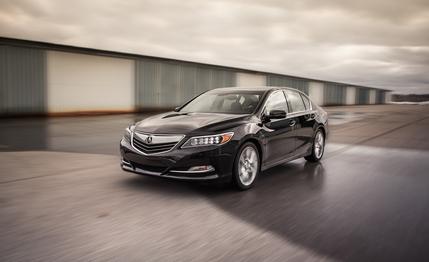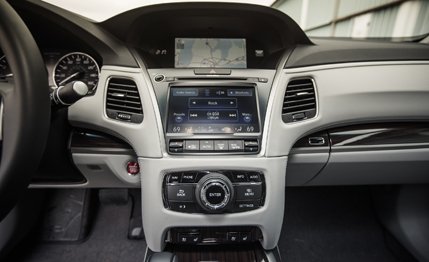 Instrumented Test
TESTED
Instrumented Test
TESTED
Why was the old Acura RL so firmly nailed to dealership floors, with just 379 sold last year? That’s easy. It was too small. Its back seat was so tight that rear riders could practically adjust the stereo, could possibly even drink from the front cup holders with a long-enough straw. Too in thrall to Honda’s minor-key virtues of frugality and modesty, the RL couldn’t compete with the chest-thumping, lane-filling champions of the mid-size luxury-car segment.
Repeat: It was because it was almost Civic-sized in back, and not because it had a six-cylinder engine or was based on a front-drive chassis. In fact, you could argue that the rest of the luxury-car fleet has finally caught up with the Acura flagship. Amid rising fuel-economy standards, a six-cylinder luxury sedan no longer seems like a tin Rolex. Furthermore, all-wheel drive is now the de rigueur luxury-car format, and Audi has even sold front-drive A6s and A8s with a straight face. All of this might not get the new RLX the respect it deserves, but what Acura has produced here, for better or worse, is a car fully in sync with these comfort-, mpg-, and tech-obsessed times.
The RLX overcompensates for the old car’s biggest failing. It’s full-figured, with a 2.0-inch-longer wheelbase and 1.7-inch-wider body than the outgoing RL’s. The cabin is far airier and roomier than before, with lots of clearance for occupants’ extremities. It’s also beautifully finished in muted tones, but its two-screen radio and nav interface is confusing; you never quite remember which of the screens and knobs will deliver the function you want. Also, the seat bottoms are too short for even the moderately lanky.

Engine downsizing touches the RLX, but only by 0.2 liter. The naturally aspirated, direct-injected 3.5-liter V-6 feeds the front wheels 310 horsepower and 272 lb-ft of torque, up 10 and 1, respectively, from the old 3.7-liter. Acceleration times are about par for the class, with the speedo needle finding 60 mph in 5.8 seconds and the quarter-mile passing in 14.3. Fuel efficiency should be very competitive, at 20/31 city/highway, figures we’re inclined to trust as they’re derived from a naturally aspirated engine. (We saw 20 mpg over about 1000 miles of mixed driving, but we drive like we’re qualifying at Monaco.)
Interestingly, Acura’s fuel-sipping strategy doesn’t rely on a tiny engine or sluggish gear ratios to achieve its result. Its final drive is actually 14 percent shorter than the RL’s, preserving the high-revving, coltish character of the powertrain primarily via careful management of its variable-valve-timing and cylinder-deactivation systems. The car retains the high-rpm urgency and natural linearity—abetted by a telepathic transmission—that are missing from the turbocharged set.
But some of the fuel saving comes from, of all places, the rear suspension. Good news, lovers of high-tech Japanese cars from the late ’80s: Rear steering is back. Acura calls it Precision All-Wheel Steer, or, cutely, P-AWS, and it can toe the wheels independently. Under braking, for example, it pigeons the rears inward to keep the car stable. It also incorporates an ersatz torque-vectoring software program dubbed agile handling assist—let's call it AHA—to rotate the car into corners with the brakes.